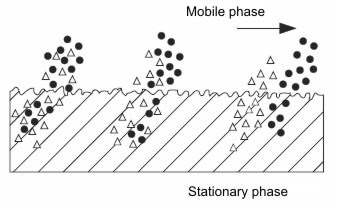What is HPLC?
What is HPLC?
HPLC or High Performance Liquid Chromatography is an analytical technique to identify and quantify substances in a solution. It can be applied to measure the concentration of carbohydrates in food and beverages, pesticides in surface water for environmental analysis, or catecholamines in urine for clinical purposes, to name a few.
UHPLC (U stands for ‘ultra’) is based on the same principle, only newer, more efficient chromatographic columns are applied. UHPLC columns are filled with smaller particles with better separation performance. Because of the narrow channels between small particles, the pressure in such system is higher. For that reason, often special instruments are required.

An HPLC system with on the left a pump with mobile phase bottles, an autosampler and a detector (right).
How does HPLC work?
An HPLC system consists of one or more pumps, an autosampler, a detector and data acquisition software. At the heart of the HPLC system is a chromatographic column, filled with stationary phase particles, where separation of substances in a mixture takes place. The instruments are connected by tubing, called the flow path. The pump(s) supply a carrier solution, or mobile phase, through the system’s flow path. The sample to be analyzed is introduced in the flow path by an autosampler. Typically, the flow rate in most HPLC’s is between 0.05 – 2 mL/min. The pressure in the system depends mostly on the particle size of the stationary phase, the column length and flow rate. Typical pressures in HPLC are from 100 to 400 bar.
The separation principle in HPLC is based on analyte distribution between stationary phase (column filled with particles) and mobile phase (solvent flowing through). In a well functioning HPLC system, the time spent in the column is unique for each substance in the mixture. This ‘retention time’ identifies the substance. In reversed phase chromatography, non-polar stationary phase particles are used. As a result, the less polar substances have a stronger interaction and spend more time in the column than polar substances.
The detector continuously measures the mobile phase that flows through the detection cell. Substances eluting from the column result in a deflection of the signal, in the shape of a Gaussian peak. The signal is stored and analyzed in a chromatogram by data acquisition software on a PC that is connected to the detector.

Schematic HPLC configuration, injection valve is part of an autosampler.

Three snapshots in time as a mixture is transported through a column. At start (left), there is no separation. When the sample plug moves further down the flow path, substances (∆ and ●) are separated.
What is a chromatogram?
A chromatogram is a graph that contains the data that is collected from an HPLC detector by data acquisition software. The data is stored in a file, it contains the signal and the retention time of a chromatographic run. Often a whole bunch of chromatograms are obtained in a sequence, containing the analyses of samples and standards for calibration. This information is used for identification and quantification, the ultimate goal of analysis. Using calibration standards, the signal height is related to concentration and the retention time identifies a substance in unknown samples.
Care must be taken that the peak measured in the sample chromatogram is not co-eluting with other substances with the same retention time. This, and other checks, are part of an assay validation.

A chromatogram with calibration standards of several neurotransmitters.